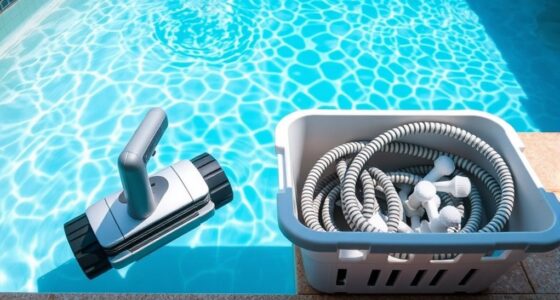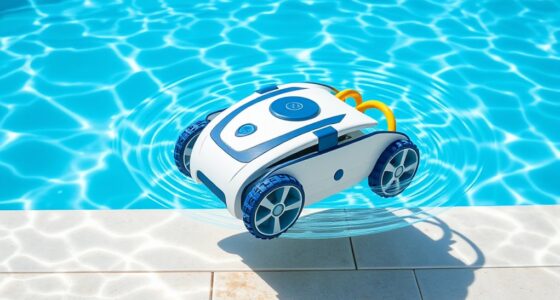Automatic pool cleaners have transformed pool maintenance by making it easier, faster, and more efficient. They use advanced sensors, navigation systems, and robotic brushes to detect dirt, avoid obstacles, and clean thoroughly without manual effort. From suction to robotic models, these devices are now smarter and eco-friendly, reducing water and energy use. If you’d like to discover how these innovations can keep your pool spotless with less hassle, explore the details further.
Key Takeaways
- Modern automatic pool cleaners utilize advanced sensors, AI, and navigation systems for efficient, thorough cleaning with minimal manual effort.
- Innovations include app connectivity, obstacle detection, and energy-efficient features like solar power, enhancing user control and sustainability.
- Robotic cleaners combine brushing, suction, and adaptive navigation to effectively handle various pool surfaces and debris types.
- Automated systems improve water chemistry management and safety by reducing slip hazards and electrical risks.
- The integration of eco-friendly materials and smart technology reflects a trend toward sustainable, environmentally conscious pool maintenance.
The Evolution of Pool Cleaning Technology
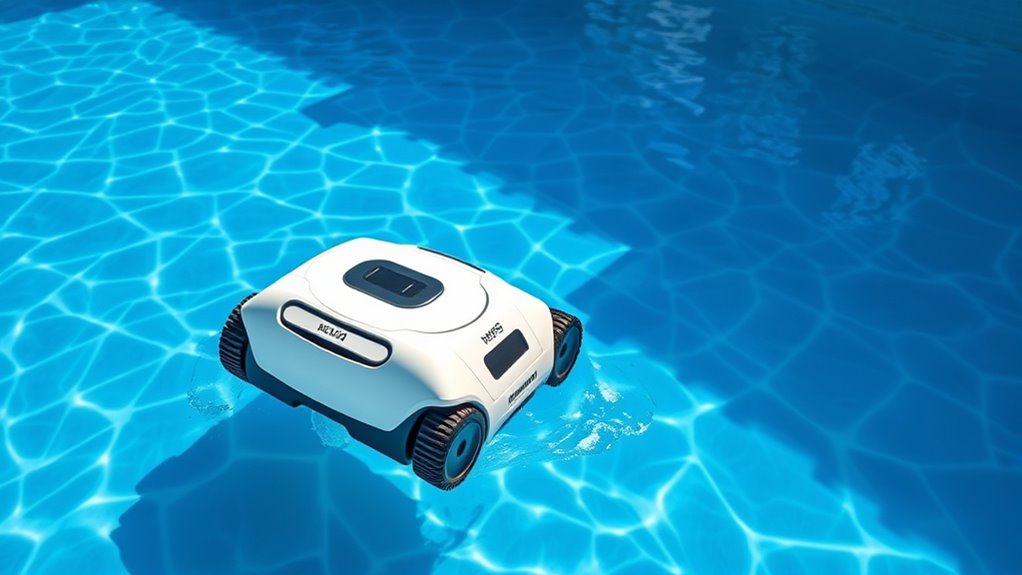
The evolution of pool cleaning technology has transformed how you maintain a spotless pool with minimal effort. Modern innovations now prioritize pool safety by reducing hazards like slips and electrical risks, thanks to improved design and automation. These advancements also help you manage water chemistry more effectively by ensuring consistent filtration and debris removal, which keeps chemicals balanced and prevents algae growth. Automated systems monitor and adapt to your pool’s needs, minimizing manual intervention and errors. As technology progresses, your pool becomes safer and healthier with less effort, giving you more time to enjoy your backyard oasis. These innovations make routine maintenance simpler, more efficient, and more reliable, ensuring your pool remains pristine and safe all season long. Additionally, the integration of advanced sensors and sensor technology improves the precision of debris detection and water quality monitoring, further enhancing the overall effectiveness of modern pool cleaners. Incorporating filter technology helps extend the lifespan of your equipment and maintains optimal water clarity, reducing the frequency of manual cleaning and chemical adjustments. This continuous innovation not only makes pool maintenance more convenient, but also contributes to the longevity of your equipment by detecting issues early.
Types of Automatic Pool Cleaners
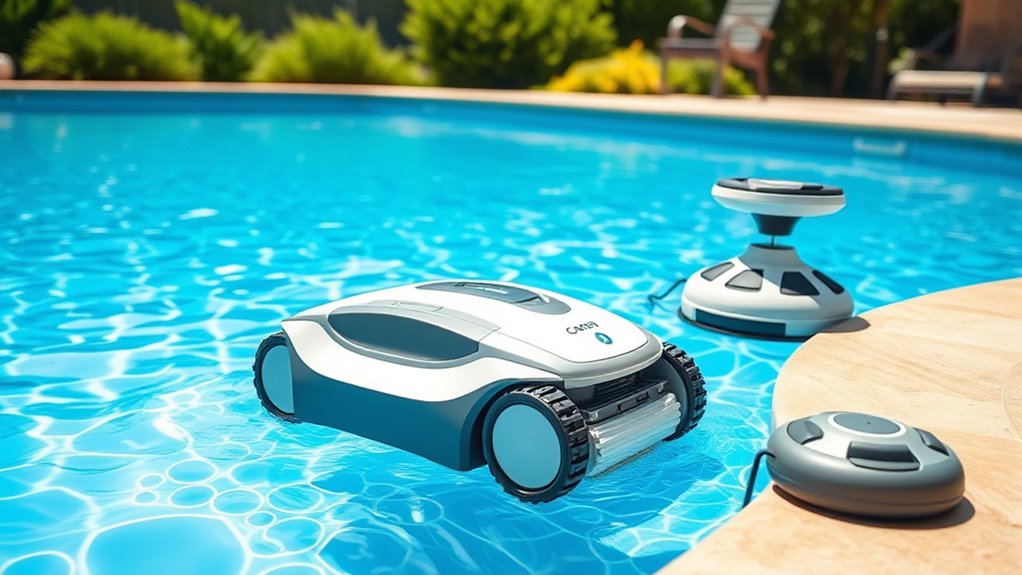
Automatic pool cleaners come in various types, each designed to suit different pool sizes, shapes, and cleaning needs. Robotic cleaners are popular for their advanced robotic navigation, allowing them to efficiently maneuver around obstacles and cover the entire pool surface. They use sophisticated cleaning algorithms to determine the best cleaning path, ensuring thorough debris removal without missing spots. Halal standards in manufacturing and materials are also important considerations for some consumers. Suction-side cleaners connect to your pool’s filtration system and are ideal for smaller pools, moving along the floor and walls. Pressure-side cleaners use the water pressure from your pump to operate, often including a bag to collect debris. Additionally, robotic cleaners that incorporate password strength evaluation and customizable cleaning modes make them versatile for various pool types. Choosing the right type depends on your pool’s specific requirements, including size, shape, and debris load. Furthermore, performance metrics like cleaning cycle time and debris capacity can influence the overall efficiency of your choice. Ensuring that the cleaner’s components meet industry safety standards is also crucial for safe operation and durability.
Key Features to Consider When Choosing a Cleaner
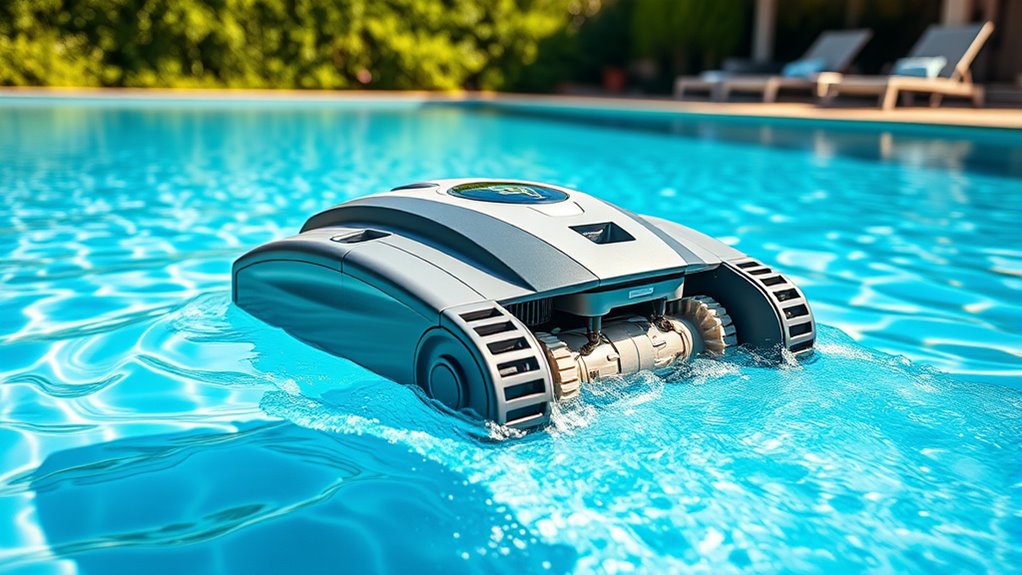
When selecting a pool cleaner, focusing on key features can help guarantee you choose the right model for your needs. First, consider how well it handles your pool surface—whether it’s a flat, textured, or uneven surface. A cleaner with adaptable navigation ensures thorough coverage. Next, look at debris collection capabilities; a model with a large filter or debris basket means less frequent emptying and more efficient cleaning. Pay attention to suction power or brush types if your pool has stubborn dirt or algae. Additionally, check the cleaner’s maneuverability and ability to reach corners and steps. These features ensure your pool stays spotless with minimal effort. By prioritizing surface compatibility and debris collection, you’ll select a cleaner that keeps your pool pristine effortlessly. Incorporating local maintenance options can also make long-term upkeep easier, especially when considering routine cleaning routines and professional support. Understanding product warranties can also help protect your investment over time. Furthermore, choosing a cleaner with advanced navigation technology can improve cleaning efficiency and coverage.
Benefits of Using Automatic Pool Cleaners
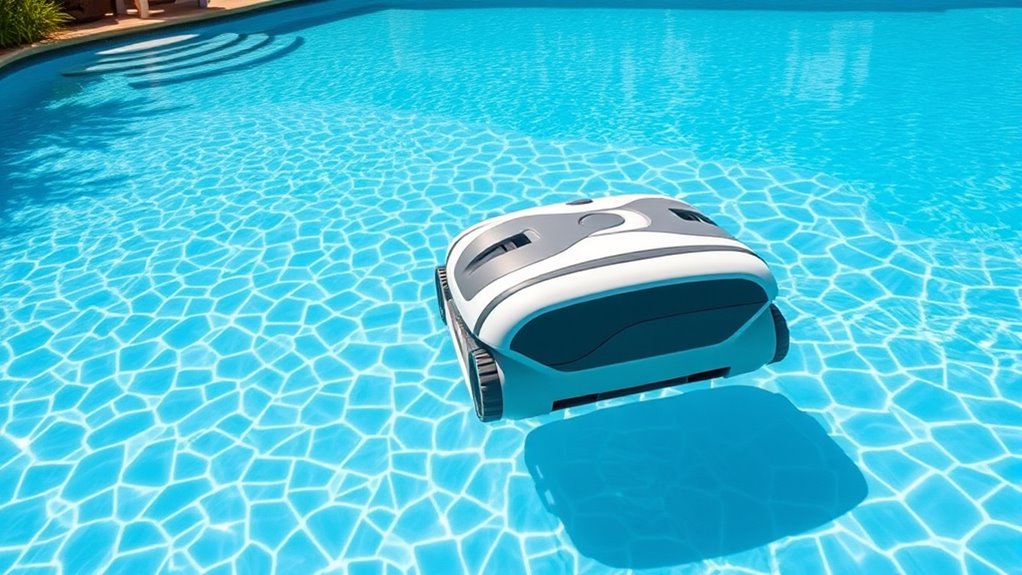
Using an automatic pool cleaner can considerably reduce the time and effort you spend on maintenance. It keeps your pool consistently clean, which enhances pool safety by preventing debris that could cause slips or injuries. Regular cleaning also helps maintain proper water chemistry, reducing the risk of algae growth and bacterial buildup. By automating the cleaning process, you ensure that the water stays clear and balanced, minimizing the need for chemical adjustments and frequent manual scrubbing. This not only makes pool ownership more convenient but also promotes a healthier swimming environment. Additionally, choosing the right pool cleaner model can optimize cleaning efficiency and extend the lifespan of your equipment. Incorporating automatic cleaning technology can further streamline your pool maintenance routine, ensuring consistent performance and reliability. Understanding the importance of personality traits such as reliability and consistency can also help you select the most effective and durable cleaning systems for your pool needs.
How Automatic Pool Cleaners Work
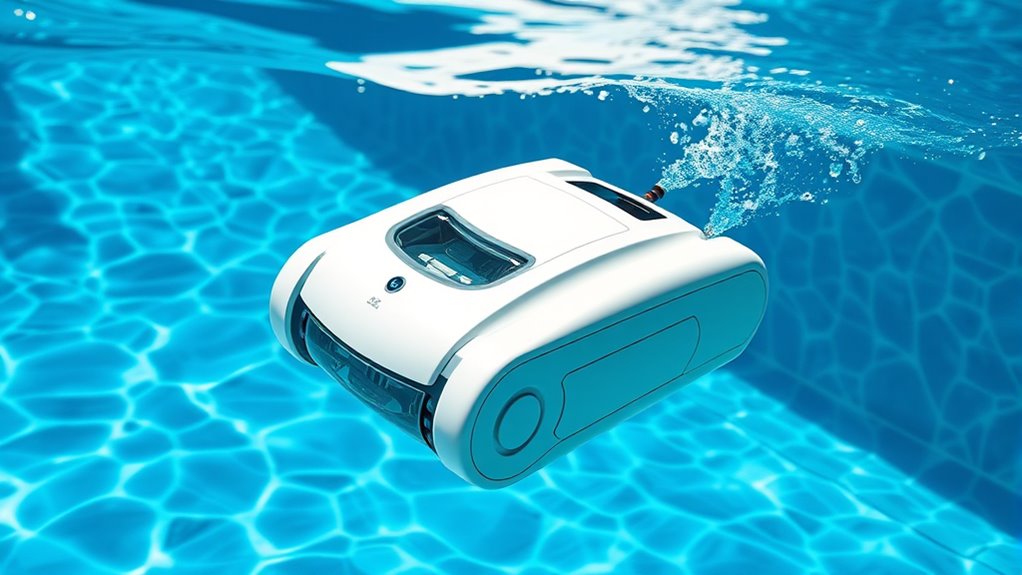
Automatic pool cleaners use sophisticated navigation systems to move efficiently around your pool and guarantee full coverage. They rely on various cleaning mechanisms, such as brushes, vacuums, or scrubbing pads, to pick up dirt and debris. Understanding how these components work together helps you choose the right cleaner for your needs. Regular maintenance of the projector bulb is essential for optimal performance and longevity of your cleaner’s components. Moreover, integrating AI automation features can optimize cleaning paths and improve overall efficiency.
Navigation Systems
Navigation systems are the brains behind how automatic pool cleaners efficiently cover the entire pool surface. They use navigation mapping to create a virtual map of your pool, ensuring thorough cleaning. Obstacle detection helps the cleaner identify objects like ladders or toys, preventing collisions and damage. These systems adapt their paths based on the pool’s shape and obstacles, optimizing coverage with minimal overlap. Some cleaners employ gyroscopes or optical sensors for precise navigation. The following table summarizes key ideas:
| Navigation Mapping | Obstacle Detection |
|---|---|
| Creates virtual map | Detects objects |
| Guides cleaner | Prevents collisions |
Cleaning Mechanisms
The cleaning mechanisms inside pool cleaners are what allow them to remove dirt, debris, and algae effectively from your pool’s surfaces. Robotic bristles sweep and agitate surfaces, loosening stubborn dirt and algae. Meanwhile, suction mechanisms create powerful vacuums that lift debris into filters or collection bins. Some cleaners combine both methods, using robotic bristles for scrubbing and suction for vacuuming, ensuring thorough cleaning. The robotic bristles rotate or vibrate to dislodge particles, making it easier for suction systems to capture them. This combination allows automatic pool cleaners to operate efficiently without manual effort. By understanding these mechanisms, you can choose a cleaner that best suits your pool’s needs, ensuring clear, clean water with less time and effort on your part.
Installation and Maintenance Tips
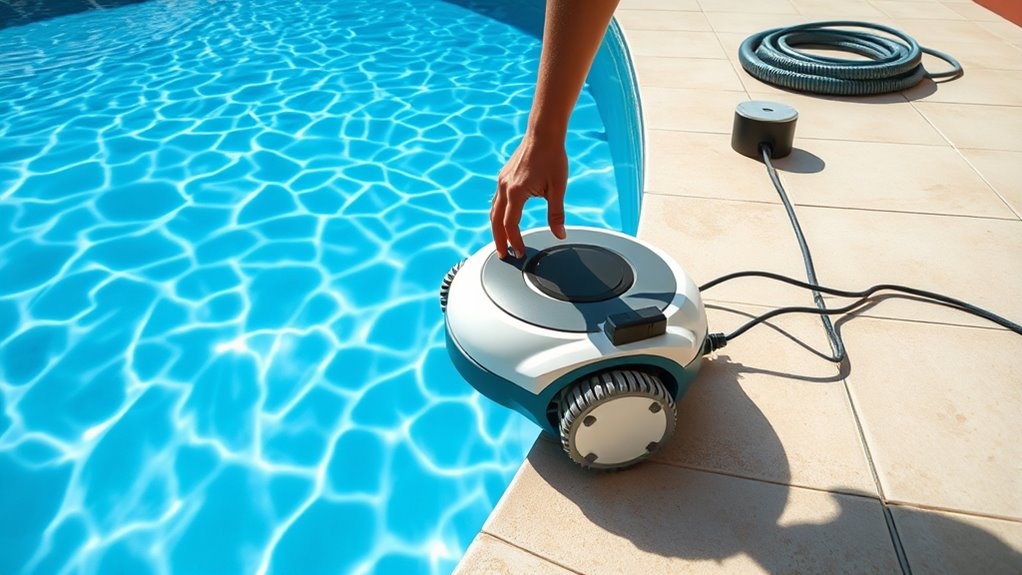
Getting your automatic pool cleaner set up correctly is key to keeping it running smoothly. You need to follow proper installation procedures to make sure issues are avoided later on. Regular maintenance practices will ensure your cleaner stays effective and lasts longer.
Proper Installation Procedures
To guarantee your automatic pool cleaner works effectively, proper installation is essential. Begin by ensuring the cleaner is compatible with your pool type and size. Follow the manufacturer’s instructions carefully, paying attention to hose connections and secure fittings. Proper placement helps maintain pool safety, preventing accidents caused by loose parts or improper operation. Check your water chemistry before installation; balanced pH and chlorine levels protect the cleaner’s components and ensure ideal performance. Avoid installing the cleaner in overly chlorinated or chemically imbalanced water, as this can damage parts over time. Regularly inspect hoses and brushes during setup to prevent leaks or malfunctions. Correct installation not only improves cleaning efficiency but also extends the lifespan of your pool cleaner, keeping your pool safe and spotless.
Routine Maintenance Practices
Routine maintenance is key to keeping your automatic pool cleaner operating efficiently and lasting longer. Regularly check and adjust your pool chemical levels to prevent algae growth and maintain water quality. Properly balanced pool water supports ideal water circulation, which helps your cleaner function effectively. Clean the filter and brushes weekly to remove debris and prevent clogs that can hinder performance. Inspect the power cord and connection points for wear or damage, ensuring safe operation. Keep the skimmer and pump baskets clear of debris to maintain water flow. Periodically test the water’s pH and chlorine levels, adjusting as needed. Consistent maintenance not only prolongs your cleaner’s lifespan but also ensures your pool stays clean, safe, and inviting with smooth water circulation.
Comparing Cost and Efficiency

When evaluating automatic pool cleaners, understanding the balance between cost and efficiency is essential. Conducting a thorough cost comparison helps you determine which model offers the best value for your investment. Higher-priced cleaners often deliver superior efficiency analysis, cleaning more thoroughly and quickly, saving you time and effort. Cheaper models may seem attractive initially but might require more frequent maintenance or replacement parts, increasing overall costs. Consider energy consumption too; efficient cleaners use less power, reducing long-term expenses. Ultimately, your goal is to find a cleaner that provides ideal cleaning performance without exceeding your budget. Comparing the upfront costs with ongoing operational expenses ensures you make a well-informed decision, maximizing both your pool’s cleanliness and your investment’s value.
Innovations Shaping the Future of Pool Cleaning
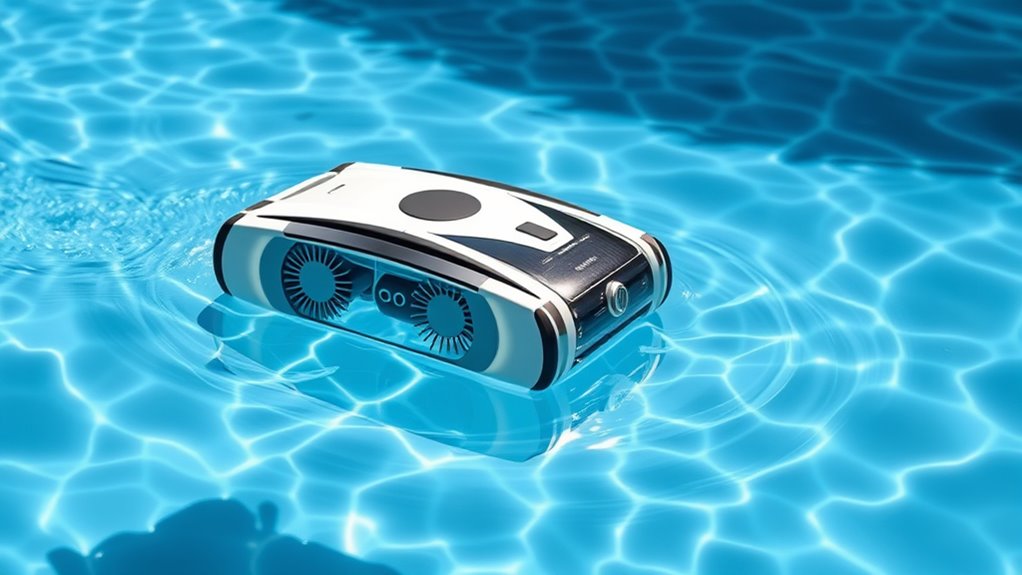
Innovations are transforming the future of pool cleaning by integrating advanced technology and smarter design features. Robotic innovations now enable cleaners to navigate pools more efficiently, avoiding obstacles and covering every inch with minimal supervision. Smart sensors play a vital role, allowing devices to detect debris, water quality, and pool shape, adjusting their cleaning patterns in real-time. These sensors help optimize energy use and extend battery life, making cleaners more effective and eco-friendly. Additionally, manufacturers are developing models with seamless app connectivity, giving you remote control and monitoring capabilities. This combination of robotic innovations and smart sensors results in smarter, faster, and more thorough cleaning processes, ensuring your pool stays pristine with less effort on your part.
Environmental Impact and Sustainable Options

As you consider automatic pool cleaners, it’s worth exploring eco-friendly technologies that reduce environmental impact. Solar-powered options can cut energy use and lower your carbon footprint. By choosing sustainable solutions, you help protect the environment while keeping your pool clean.
Eco-Friendly Cleaning Technologies
Eco-friendly cleaning technologies are transforming pool maintenance by minimizing environmental impact and promoting sustainability. You can choose automatic cleaners equipped with biodegradable filters that break down naturally, reducing waste and landfill contributions. Reusable scrubbing pads are another eco-conscious feature, allowing you to clean your pool effectively without constantly replacing disposable materials. These pads can be washed and reused multiple times, cutting down on plastic waste and lowering your overall environmental footprint. By selecting cleaners with these sustainable components, you not only maintain a clean pool but also support eco-friendly practices. These technologies help you reduce chemical use and energy consumption, making your pool maintenance more responsible and environmentally conscious. Embracing these innovations ensures you contribute to a healthier planet while enjoying a sparkling pool.
Solar-Powered Pool Maintenance
Have you considered how solar-powered pool cleaners can reduce your environmental footprint? These cleaners harness solar efficiency, converting sunlight into energy to operate, which means less reliance on traditional power sources. They’re eco-friendly, emitting no harmful emissions during use. Plus, advancements in battery longevity guarantee your cleaner stays functional longer without frequent replacements. Imagine a cleaner that:
- Uses solar panels to power its movement
- Runs quietly, reducing noise pollution
- Saves energy costs over time
- Minimizes carbon emissions
- Offers sustainable, low-maintenance operation
Tips for Maximizing Performance and Longevity
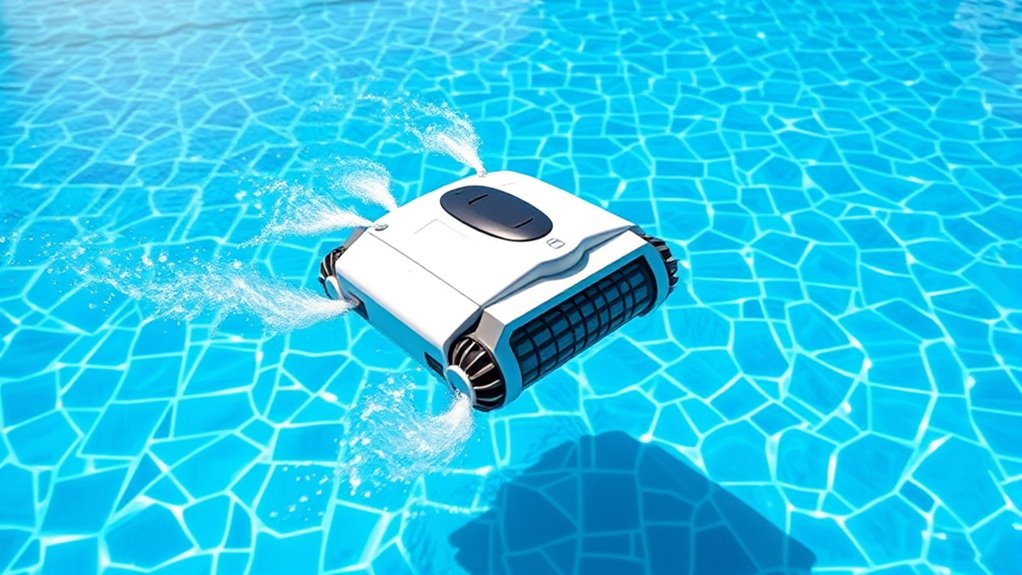
To get the most out of your automatic pool cleaner, regular maintenance and careful operation are essential. Keep your pool chemistry balanced, as proper pH and chemical levels prevent debris buildup and protect the cleaner’s components. Always follow safety precautions when handling electrical parts and cleaning equipment to avoid accidents. Regularly inspect and clean the filter and brushes to ensure peak performance. Store your cleaner in a dry, cool place when not in use to extend its lifespan. Avoid running the cleaner during storms or heavy winds, which can cause damage or hinder cleaning efficiency. By maintaining proper pool chemistry and practicing safety, you’ll maximize your cleaner’s performance and longevity, saving you time and money while keeping your pool sparkling clean.
Frequently Asked Questions
How Do Automatic Pool Cleaners Handle Algae or Heavy Debris?
Automatic pool cleaners handle algae removal and heavy debris handling effectively. They use powerful scrubbing brushes and strong suction to clean algae from pool surfaces and remove heavy debris like leaves and dirt. You just need to guarantee your cleaner is equipped with the right features, such as adjustable settings for algae and debris, so it can thoroughly clean your pool without manual effort. Regular maintenance keeps them performing at their best.
Are Automatic Pool Cleaners Suitable for All Pool Shapes and Sizes?
Automatic pool cleaners are versatile, but their suitability depends on your pool’s shape and size. You’ll find many models offer excellent pool shape versatility and size adaptability, making them suitable for most pools. However, irregularly shaped or very large pools might need specialized or more powerful cleaners. To guarantee the best fit, check the product specifications and choose a cleaner designed to handle your specific pool shape and size.
What Safety Precautions Should I Take During Cleaner Installation?
Imagine installing your pool cleaner like planting a seed for safety. You should prioritize electrical safety by turning off power before installation and avoid loose wiring. Make certain proper anchoring of the device to prevent it from drifting or causing damage. Follow manufacturer instructions carefully, and if unsure, consult a professional. These steps protect you and your pool, turning your cleaning routine into a safe, worry-free oasis.
Can Automatic Pool Cleaners Be Used in Saltwater Pools?
You can definitely use automatic pool cleaners in saltwater pools. Just check the saltwater compatibility of the cleaner before purchasing, as some models are specifically designed for saltwater environments. Using the right cleaner minimizes environmental impact by preventing corrosion and prolonging the device’s lifespan. This ensures efficient cleaning without harming your pool or the environment, making maintenance easier while protecting your investment.
How Often Should I Service or Replace Parts of My Pool Cleaner?
To keep your pool cleaner working efficiently, follow a regular maintenance schedule and monitor parts for wear. Typically, you should check and clean filters weekly, and replace brushes or hoses every 6 to 12 months, depending on usage. Regularly inspect for damage, and perform part replacement as needed to prevent breakdowns. Staying on top of maintenance guarantees your cleaner operates smoothly and extends its lifespan.
Conclusion
As you embrace the evolution of pool cleaning, remember each cleaner is a lighthouse guiding you through the fog of maintenance. Their technology symbolizes progress, efficiency, and care for your oasis. By choosing wisely and maintaining your device, you guarantee it remains a steadfast guardian of sparkling waters. In this dance with innovation, you forge a harmonious bond, turning routine chores into a symphony of cleanliness that reflects your dedication and respect for your personal paradise.





